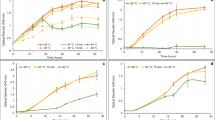Abstract
A unique non-pathogenic strain of Fusarium oxysporum was isolated from field-collected plants of Agave victoria-reginae Moore. It was then re-introduced into micropropagated plants of the same species under greenhouse conditions. The fungic inoculation induced a 225% increase in the length of roots, 50% in the number of root branches and 50% in the number of stomata on the adaxial surface of leaves. Also, an increment of 167% in nocturnal acidity and a 122% in malic acid was observed and nocturnal pH was significantly more acid in the inoculated plants. Total chlorophyll and sugar content increased 14 and 172%, respectively. These results indicate a higher photosynthetic efficiency of the plants inoculated with the fungus than those plants which were not inoculated; therefore the association of this unique F. oxysporum strain with A. victoria-reginae Moore was considered as a beneficial symbiosis.
Similar content being viewed by others
References
Alves-Santos FM, Benito PE, Eslava PA & Diaz-Minguez JM (1999) Genetic diversity of Fusarium oxysporum strains from common bean fields in Spain. Appl. Environ. Microbiol. 65: 3335–3340
Appel DJ & Gordon TR (1996) Relationships among pathogenic and non-pathogenic isolates of Fusarium oxysporum based on the partial sequence of the intergenic spacer region of the ribosomal DNA. Mol. Plant-Microbe Interact. 9: 125–138
Bacon CW (1993) Abiotic stress tolerances (moisture, nutrients) and photosynthesis in endophyte-infected tall fescue. Agr. Ecosyst. Environ. 44: 123–141
Belesky DP, Devine OJ, Pallas JE Jr. & Stringer WC (1987) Photosynthetic activity of tall fescue as influenced by a fungal endophyte. Photosynthetica 21: 82–87
Cervantes-Martínez J, Flores-Hernández R, Rodríguez-Garay B & Santacruz-Ruvalcaba F (2002) Detection of bacterial infection of agave plants by laser-induced fluorescence. Appl. Opt. 41: 2541–2545
Cushman JC & Bohner HJ (1997) Molecular genetics of crassulacean acid metabolism. Plant Physiol. 113: 667–676
Estrada-Luna AA, Davies FT & Egilla JN (2000) Mycorrhizal fungi enhancement of growth and gas exchange of micropropagated guava plantlets (Psidium guajava L.). Mycorrhiza 10: 1–18
Freeman S & Rodriguez RJ (1993) Genetic conversion of a fungal plant pathogen to a non-pathogenic, endophyte mutualist. Science 260: 75–78
Fuchs JG & Moënne-Loccoz Defago G (1997) Non-pathogenic Fusarium oxysporum strain Fo47 induces resistance to Fusarium wilt in tomato. Plant Dis. 81: 492–496
Fuchs JG & Moënne-Loccoz Defago G (1999) Ability of non-pathogenic Fusarium oxysporum Fo47 to protect tomato against Fusarium wilt. Biol. Control 14: 105–110
Gange A & Ayres R (1999) On the relation between arbuscular micorrhizal colonization and plant benefit. Oikos 87: 615–621
Gordon TR & Martin RD (1997) The evolutionary biology of Fusarium oxysporum. Annu. Rev. Phytopathol. 35: 111–128
Lemanceau P, Bakker PAHM, De Kogel WJ, Alabouvette C & Schippers B (1992) Effect of pseudobactin 358 by Pseudomonas putida WCS358 on suppression of fusarium wilt of carnations by non-pathogenic Fusarium oxysporum Fo47. Appl. Environ. Microbiol. 58: 2978–2982
Lemanceau P, Bakker PAHM, De Kogel WJ, Alabouvette C & Schippers B (1993) Antagonistic effect of non-pathogenic Fusarium oxysporum strain Fo47 and pseudobactin 358 upon pathogenic Fusarium oxysporum f. sp. dianthi. Appl. Environ. Microbiol. 59: 74–82
Loewe A, Einig W, Shi L, Dizengremel P & Hampp R (2000) Mycorrhiza formation and elevated CO both increase the 2capacity for sucrose synthesis in source leaves of spruce and aspen. New Phytol. 145: 565–574
Mathur N & Vyas A (2000) Influence of arbuscular mycorrhizae on biomass production, nutrient uptake and physiological changes in Ziziphus mauritiana Lam. under water stress. J. Arid Environ. 45: 191–195
Montgomery DC (1997) Design and Analysis of Experiments. 4th edn. John Wiley and Sons
Murashige T & Skoog F (1962) A revised medium for rapid growth and bioassays with tobacco tissue culture. Physiol. Plant. 15: 473–497
Nobel PS & Hartsock TL (1983) Relationships between photosynthetically active radiation, nocturnal acid accumulation and CO2 uptake for a crassulacean acid metabolism plant, Opuntia ficus-indica. Plant Physiol. 71: 71–75
Paulitz T C & Belanger RR (2001) Biological control in greenhouse systems. Annu. Rev. Phytopathol. 39: 103–133
Phillips GC & Collins GB (1979) In vitro tissue cultures of legumes and plant regeneration from callus cultures of red clover. Crop Sci. 19: 59–64
Read DJ (1999) Mycorrhiza-the state of the art. In: Varma A & Hock B (eds) Mycorrhiza (pp. 3–34). Springer-Verlag, Berlin, Germany
Redman SR, Dunigan DD & Rodríguez RJ (2001) Fungal symbiosis from mutualism to parasitism: who controls the outcome, host or invader? New Phytol. 151: 705–716
Redman SR, Sheehan BK, Stout GR, Rodriguez RJ & Henson MJ (2002) Thermotolerance generated by plant / fungal symbiosis. Science 298: 158
Rodríguez-Garay B, Acosta-Dueñas B & Gutiérrez-Mora A (1996) Somatic embryogenesis of Agave victoria-reginae Moore. Plant Cell Tiss. Org. Cult. 46: 85–87
Robles-Murguía C. (1994) Estudio-anatómico fisiológico comparativo entre el nopal Opuntia ficus indica (L) Miller y el pitayo Stenocereus queretaroensis (Webb. Buxbaum) Tesis de licenciatura Universidad de Guadalajara, México
Schulz B, Guske S, Dammann U & Boyle C (1998) Endophyte-host interactions. II. Defining symbiosis of the endophyte-host interaction. Symbiosis 25: 213–227
Smith SE & Read DJ (1997) Mycorrhizal Symbiosis (589). Academic Press, San Diego, California
Sutton BG, Ting IP & Sutton R (1981) Carbohydrate metabolism of cactus in a desert environment. Plant Physiol. 68: 784–787
Taiz L & Zeiger E (1998) Plant Physiology. 2nd edn. (p. 792). Sinauer Associates Inc, Sunderland, MA
Warwick LM, Gray PP, Nippard GJ & Quinlan MR (1982) Evolution of the DNS method for analysis lignocellulosic hydrolisates. J. Chem. Tech. Biotechnol. 32: 1016–1022
Author information
Authors and Affiliations
Corresponding author
Rights and permissions
About this article
Cite this article
Obledo, E.N., Barragán-Barragán, L.B., Gutiérrez-González, P. et al. Increased photosyntethic efficiency generated by fungal symbiosis in Agave victoria-reginae . Plant Cell, Tissue and Organ Culture 74, 237–241 (2003). https://doi.org/10.1023/A:1024046925472
Issue Date:
DOI: https://doi.org/10.1023/A:1024046925472




